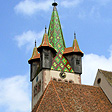MUSEE
LALIQUE – ALSACE-WINGEN
Museum of Art Nouveau and Art Deco Glass & Jewelry
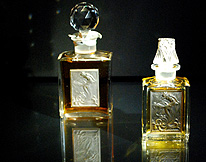 One
of the most famed of the designers of crystal and jewelry of two entirely
different eras, the name of Lalique invokes elegance, style
and beauty. René Jules Lalique was born in a small French village
in 1860. He began sketching designs at the age of 12 in the College of
Turgot, and at 14 after his father’s death, began work as an apprentice
to Paris goldsmith Louis Aucoc. His talent was soon recognized and he
went on to design jewelry for Cartier and Bucheron in the height of the
age of Art Nouveau.
One
of the most famed of the designers of crystal and jewelry of two entirely
different eras, the name of Lalique invokes elegance, style
and beauty. René Jules Lalique was born in a small French village
in 1860. He began sketching designs at the age of 12 in the College of
Turgot, and at 14 after his father’s death, began work as an apprentice
to Paris goldsmith Louis Aucoc. His talent was soon recognized and he
went on to design jewelry for Cartier and Bucheron in the height of the
age of Art Nouveau.
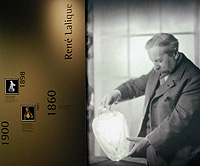 In
1885, he opened his own business and 1890, he was recognized as one
of the foremost artisans the style in glass and
jewelry through his Maison de’l Art Nouveau. When tastes changed
with the industrialization of the First World War and the introduction
of Art Deco, almost diametrically opposed to the earlier form, René Lalique
transformed his art as one of the leaders of the movement in the 1920s.
But it was his meeting with French perfumer Francois Coty in 1908 which
transformed his business, when he began designing artfully elegant bottles
for the foremost perfumer of the age, and adding boxes, vases and lamps
to his product line.
In
1885, he opened his own business and 1890, he was recognized as one
of the foremost artisans the style in glass and
jewelry through his Maison de’l Art Nouveau. When tastes changed
with the industrialization of the First World War and the introduction
of Art Deco, almost diametrically opposed to the earlier form, René Lalique
transformed his art as one of the leaders of the movement in the 1920s.
But it was his meeting with French perfumer Francois Coty in 1908 which
transformed his business, when he began designing artfully elegant bottles
for the foremost perfumer of the age, and adding boxes, vases and lamps
to his product line.
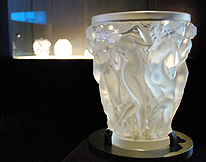 Seeing the potential for expansion through the production of perfume
bottles, Lalique first rented a glassworks near Paris in 1909, but found
it was not sufficient to meet demand. Taking advantage of government
incentives to redevelop the war ravaged regions of Alsace and Moselle
following the war, he looked to open a factory in the Northern Vosges.
First he approached the legacy crystal factories of both Saint-Louis
Le Bitche and Meisenthal in the Moselle region of Loraine, but rather
than share facilities, finally decided to build his new glass factory
in Wingen-sur-Moder, a short distance away in neighboring Alsace along
the Moder River, in a former glassworks of Hochberg opening in 1921.
Seeing the potential for expansion through the production of perfume
bottles, Lalique first rented a glassworks near Paris in 1909, but found
it was not sufficient to meet demand. Taking advantage of government
incentives to redevelop the war ravaged regions of Alsace and Moselle
following the war, he looked to open a factory in the Northern Vosges.
First he approached the legacy crystal factories of both Saint-Louis
Le Bitche and Meisenthal in the Moselle region of Loraine, but rather
than share facilities, finally decided to build his new glass factory
in Wingen-sur-Moder, a short distance away in neighboring Alsace along
the Moder River, in a former glassworks of Hochberg opening in 1921.
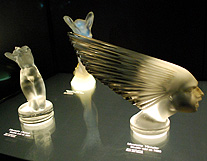 The Musée Lalique, newly redesigned and opened in the summer of
2011 is built on the site of the former historic Hochberg glassworks,
next to the current factory, integrating portions of the old building
of brick with the new modern concrete and glass design in the landscape
which encompasses workshop housing and gardens. The museum covers the
designer’s long career, but focuses mostly on the output produced
at the Alsace factory. The collection features jewelry, design drawings
and illustrations, perfume bottle, glass art and Lalique crystal lamps,
iconic car hood ornaments, and the glasswork which adorned ocean liners
and the coaches of the Orient Express.
The Musée Lalique, newly redesigned and opened in the summer of
2011 is built on the site of the former historic Hochberg glassworks,
next to the current factory, integrating portions of the old building
of brick with the new modern concrete and glass design in the landscape
which encompasses workshop housing and gardens. The museum covers the
designer’s long career, but focuses mostly on the output produced
at the Alsace factory. The collection features jewelry, design drawings
and illustrations, perfume bottle, glass art and Lalique crystal lamps,
iconic car hood ornaments, and the glasswork which adorned ocean liners
and the coaches of the Orient Express.
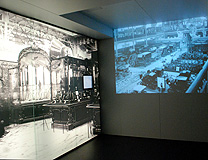 Original
design drawings are presented in the museum's graphics room. 230
perfume bottles, created after his
meeting with Coty mark the artist's shift from the production of jewelry
to glass. There is no tour of the actual Lalique factory next door,
but an interactive touch table demonstrates the various stages
in the manufacture
of the Bacchantes vase still produced by the Lalique Company, now owned
by the Swiss Art et Fragrance Group, and a multi-screen video wall
honors the glassmakers working in the factory.
Original
design drawings are presented in the museum's graphics room. 230
perfume bottles, created after his
meeting with Coty mark the artist's shift from the production of jewelry
to glass. There is no tour of the actual Lalique factory next door,
but an interactive touch table demonstrates the various stages
in the manufacture
of the Bacchantes vase still produced by the Lalique Company, now owned
by the Swiss Art et Fragrance Group, and a multi-screen video wall
honors the glassmakers working in the factory.
Visiting the Musee Lalique
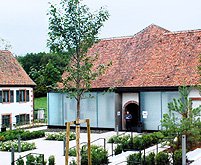 The Lalique Museum is located on the Rue de Hochberg in Wingen-Sur-Moder.
Open daily from 10 am to 7 pm from April 1st to September 30 and from
October to March, Tuesday to Sunday from 10 am to 6 pm, closed on Mondays
and the month of January. Last admission is an hour before closing.
Admission is €6 for adults, €3 for student, seniors and children 6-16,
children under 6 are free. There is a shop on the premises to purchase
some Lalique crystal or souvenirs (hey, a genuine Lalique Bacchantes
Vase will only set you back about €3200) and a snack bar. You can
picnic in the gardens and there are two car parks. To get to the Musée
Lalique by train, Wingen-sur-Moder is 45 minutes from Strasbourg via
the Strasbourg-Sarreguemines TER regional express line, and the museum
is about a mile from the station. For more crystal, the glass factories
of Meisenthal and Saint Louis are about 10-15 minutes away by car (see Saint-Louis Crystal). Each
has its own museum exhibit and the three factories have joined together
to offer a coupon for visitors of one to see the others at a discount. © Bargain
Travel Europe
The Lalique Museum is located on the Rue de Hochberg in Wingen-Sur-Moder.
Open daily from 10 am to 7 pm from April 1st to September 30 and from
October to March, Tuesday to Sunday from 10 am to 6 pm, closed on Mondays
and the month of January. Last admission is an hour before closing.
Admission is €6 for adults, €3 for student, seniors and children 6-16,
children under 6 are free. There is a shop on the premises to purchase
some Lalique crystal or souvenirs (hey, a genuine Lalique Bacchantes
Vase will only set you back about €3200) and a snack bar. You can
picnic in the gardens and there are two car parks. To get to the Musée
Lalique by train, Wingen-sur-Moder is 45 minutes from Strasbourg via
the Strasbourg-Sarreguemines TER regional express line, and the museum
is about a mile from the station. For more crystal, the glass factories
of Meisenthal and Saint Louis are about 10-15 minutes away by car (see Saint-Louis Crystal). Each
has its own museum exhibit and the three factories have joined together
to offer a coupon for visitors of one to see the others at a discount. © Bargain
Travel Europe
Find best travel deals in Moselle Lorraine on TripAdvisor
Web Info
Musee
Lalique
These articles are copyrighted and the sole property of Bargain Travel Europe and WLPV, LLC. and may not be copied or reprinted without permission.
See Also:
MAGINOT LINE FORT SIMSERHOF – BITCHE

